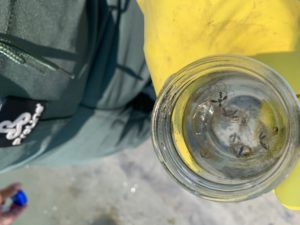 Montclair Photo/Clinging jellyfish taken from North Wildwood salt pond.
Montclair Photo/Clinging jellyfish taken from North Wildwood salt pond.
TRENTON The NJ Department of Environmental Protection is advising the public that clinging jellyfish have been confirmed in a salt pond near a bathing area in North Wildwood, the first time this species has been found this far south in New Jersey.
Ranging from about the size of a dime to the size of a quarter, the clinging jellyfish is difficult to spot in the water. It has a powerful sting that can produce severe pain and other localized symptoms. In some cases, stings can result in the need for medical attention or hospitalization.
It is unclear how clinging jellyfish entered the pond, which is located adjacent to E. 1st Avenue and near the Hereford Inlet Lighthouse. The pond is fed by a stormwater pipe from adjacent roadways and may have intermittent direct connections with Hereford Inlet.
The DEP is working with the New Jersey Department of Health to ensure that appropriate local health agencies are alerting the public to use caution or avoid wading through this pond, according to a release.
The DEP is collaborating with Montclair State University to monitor clinging jellyfish in the pond and are continuing their investigation in other focus areas. The DEP and Montclair have increased seasonal monitoring this year and are working to better understand the invasive history and connections between the known and recently discovered populations.
The DEP and Montclair have been aggressively monitoring for clinging jellyfish since they were first confirmed in New Jersey in 2016. Since the first confirmation, clinging jellyfish sightings had been confined to parts of northern and central Barnegat Bay, in addition to the Metedeconk and Shrewsbury rivers.
The clinging jellyfish tends to attach to submerged aquatic vegetation and algae in back bays and estuaries when not actively feeding, areas that are not heavily used for swimming. Locations where clinging jellyfish have been confirmed can be accessed by clicking here.
The clinging jellyfish observed in the salt pond in North Wildwood were collected by a young girl. Her parents astutely recognized that they may be clinging jellyfish and contacted Dr. Paul Bologna of Montclair State University, who visited the pond and pulled about 150 specimens from the water. The girl was not injured while collecting.
The DEP encourages the public to exercise common sense and caution during recreation in areas where the jellyfish have been discovered. Anyone wading through these areas, especially near aquatic vegetation or areas with dense macroalgae, should take precautions, such as wearing boots or waders to protect themselves. Swimming near lifeguarded beaches is, as always, encouraged.
If stung by a clinging jellyfish, rinse the area with salt water and remove any remaining tentacle materials using gloves or a thick towel. Seek medical attention as appropriate.
The clinging jellyfish is non-native species. It has a red, orange or violet cross across its middle. Each jellyfish can have 60 to 90 tentacles that contain stinging cells capable of delivering painful neurotoxins. Clinging jellyfish primarily feed on zooplankton.
Both the adult, or medusa, and polyp stages of the clinging jellyfish are capable of stinging, a mechanism they use to stun prey and to defend against predators.
For a DEP clinging jellyfish fact sheet, visit http://www.nj.gov/dep/docs/clinging-jellyfish-factsheet.pdf